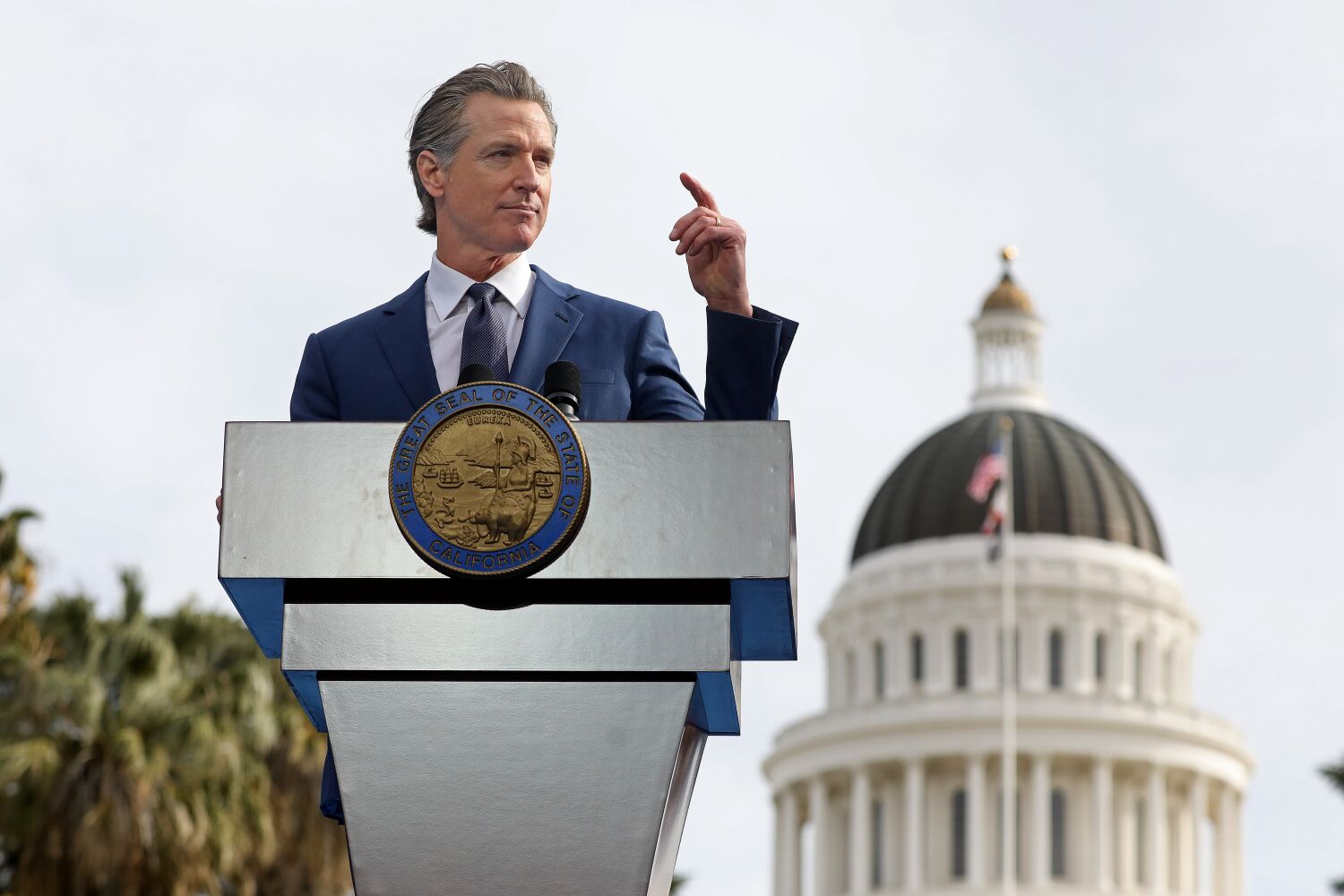Global Courant 2023-05-12 23:46:55
California Governor Gavin Newsom has detailed plans to rein in his progressive policy agenda to offset an estimated $31.5 billion budget deficit for the state during a presentation Friday in which he outlined his revised spending proposal.
The state expects tax collections in the coming fiscal year to fall short of money allocated to programs essential to millions of Californians, forcing the governor to take a more conservative spending approach as he tries to protect many of his major programs.
The governor’s proposal includes shifting funding to bonds, tapping $450 million from the state’s safety net reserve, and renewing a tax on managed care programs to support Medi-Cal, while continuing plans to implement increases for climate – and transport programs.
The projections indicate that the generosity of Newsom’s first term is over and that the extent to which he is forced to retire now and in years to come may have implications for Democrats in the state legislature and his own political legacy.
“This has not been an easy budget, but I hope you see that we did our best to hold the line and take care of the most vulnerable and neediest, but still remain careful,” Newsom said.
“I am well aware of how concerned people have been about the impact on these basic core issues: education, housing for the homeless, healthcare, mental health, climate policy, public safety in general, and of course the issues of economic development, jobs, workforce development,” said Newsom.
As expected, the state’s budget gap widened following January estimates of a $22.5 billion deficit and marks a dramatic turn from last summer, when Newsom touted a $100 billion surplus.
Anticipating the possibility of a budget deficit, Newsom and Democrats have been careful in recent years to largely avoid creating costly new programs or entitlements, instead budgeting most of the excess revenue for one-time funding allocations.
The governor’s revised $306.5 billion budget proposal largely calls for the state to cut funding increases for programs, with little to no calls for immediate cuts below current investment levels for programs and services.
Why are budget protections so uncertain this year?
Unlike in previous years, more uncertainty looms over California’s financial situation at this point in the budget process, raising the possibility of budget cuts.
The federal and state governments this year extended income tax filing deadlines from April to October for most Californians, delaying the state’s ability to get a more concrete picture than expected of its income until this fall . In California, residents of 55 of 58 counties, representing about 99% of the population, are allowed to file late without consequences.
Newsom said the state plans to defer cash receipts will total about $42 billion.
The federal government is also on the verge of defaulting on its debts, adding to uncertainty.
How did the state go so drastically from too much money to too little?
California’s state budget relies heavily on income tax revenues paid by the highest earners and is therefore subject to the ebb and flow of capital gains in the stock market, bonuses to executives, and IPOs — IPOs when companies begin to sell stock to investors.
Chris Thornberg, an economist and founder of Beacon Economics in Los Angeles, said the shortage was predictable and self-made by politicians.
Federal COVID-19 stimulus funding artificially inflated state income taxes higher than ever before, resulting in the record surplus. And what goes up must come down, he said.
Newsom said during his presentation that capital gains will account for 11.3% of personal income in California by 2021.
“If capital markets were rising at a nice steady rate year-over-year, this wouldn’t happen, but it isn’t,” Thornberg said. “They rise up and then collapse again.”
It would have been prudent to set aside the surplus and not spend it rather than spend the money on one-time programs, Thornberg said.
Newsom has repeatedly emphasized his decision to limit most new spending to one-time funds, a strategy that avoids placing new permanent demands on the state budget as revenues fall.
But even temporary programs can be costly. The governor and legislators provided $9.2 billion in gas rebates for 32 million Californians since the approval of payments in a budget agreement last June.
Thornberg said the state has seen the same kind of revenue rise and fall twice over the past quarter century, in the late 1990s and mid-2000s.
“Both times the state was hit with a $30 billion shortfall because of this,” Thornberg said. “It was perfectly clear what happened this time and they all acted like it wasn’t a big deal, and here we go again.”
Does this mean we are in a recession?
The U.S. economy is not in recession, a fact that Thornberg says protects the state from free-falling into a larger fiscal crisis.
California’s unemployment rate continued to rise a low 4.4% in March, the most recent month for which figures are available. Jerry Nickelsburg, director of the UCLA Anderson Forecast and professor of economics, said job numbers also hit an all-time high that month.
“The data tells us that, sector by sector, California should outperform the US in the coming years, and California has been growing faster than the US for decades,” Nickelsburg said. “We expect that to be the case or, if there was a decline in 2023, that it will be milder in California than in the US”
Whether a recession is on the horizon remains an open question, Nickelsburg said.
The kind of imbalances that normally cause a recession, such as too many houses being built or too many cars for sale, do not exist at the moment. But the delayed impact of previous rate hikes has yet to materialize in full, and the Federal Reserve could continue to raise rates, he said.
Thornberg was more optimistic.
“The reality is the economy is fine,” Thornberg said. “Consumers still have tons of money. There are no bankruptcies. The housing market, while overpriced, is solid. There are no bad debts there. The whole thing is exaggerated.”
What’s next?
A governor’s May revised budget proposal traditionally serves as a catalyst for intensified spending negotiations with the legislature. Lawmakers have until June 15 to approve a budget for the next fiscal year.
The two sides already disagree on how to proceed.
The state senate introduced a plan late last month to offset the budget deficit by raising taxes on about 2,500 of the largest companies operating in the state and deferring an existing tax credit for companies posting a net operating loss . Senate Budget Committee Chair Nancy Skinner (D-Berkeley) said the proposal would reverse some of the Trump-era corporate tax cuts. She estimated the change could bring in $7 billion in the first year and $6 billion each subsequent year.
Newsom’s office responded with a firm “no.”
“Government Newsom cannot support the new tax increases and massive current spending proposed by the Senate,” Anthony York, the governor’s communications adviser, said in a statement. “It would be irresponsible to jeopardize the progress we’ve made together over the past decade to protect the most vulnerable while putting our state on a sound fiscal footing.”
In January, Newsom proposed cutting funding increases for climate change programs and transportation and delaying investments for 20,000 new childcare places.
Instead, Assembly Speaker Anthony Rendon (D-Lakewood) has suggested the state dip into its Rainy Day fund, which he says was made for this kind of situation.
So far, Newsom has declined to tap the $23.3 billion fund, given economic uncertainty across the country and the potential need for those funds later in the event of a recession.
Newsom’s budget plan suggests that the revenue decline through 2026-2027 could be another $100 billion.







